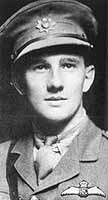Related Research Articles
Group Captain Geoffrey Hilton "Beery" Bowman, was a British First World War fighter ace credited with 32 victories. After attaining the rank of major in the Royal Flying Corps, he later became a group captain in the Royal Air Force.
Percy Jack Clayson was a British flying ace in the First World War credited with 29 victories.
Lieutenant Alfred Victor Blenkiron was a British World War I flying ace credited with five aerial victories.
Major Charles Hubert Jeffs was a British World War I flying ace credited with five aerial victories.
Captain Frank Douglas Stevens was a British First World War flying ace credited with five aerial victories.
Captain Reginald Morse Charley was a British World War I flying ace credited with six aerial victories.
Major Victor Henry Huston was a First World War flying ace credited with six aerial victories. He was the only ace in his squadron.
Lieutenant Maximillian John Jules Gabriel Mare-Montembault MC was a British World War I flying ace credited with six aerial victories.
Lieutenant Robert McLaughlin was a British World War I flying ace credited with six aerial victories.
Captain Thomas Sydney Sharpe was a British World War I flying ace credited with six aerial victories.
Captain Ian Donald Roy McDonald was a British World War I flying ace credited with 20 aerial victories. Although born in the British West Indies, he returned to England to serve in the air force. After his successful career in combat, he spent a short time at home before returning to the colours. He served in Iraq postwar, and was executed there by insurgents.
Captain Reginald Howard Rusby Distinguished Flying Cross|DFC was a World War I flying ace credited with ten aerial victories.
Captain Guy Borthwick Moore (1895-1918) was a Canadian World War I flying ace credited with ten aerial victories.
Lieutenant Colonel Spencer Bertram Horn was a British soldier and World War I flying ace credited with thirteen aerial victories. Although seconded to aviation duty during the First World War, he returned to his Dragoon Guards regiment after the war ended. Horn then served in India in the 1920s and 1930s, while his cavalry unit modernised to tanks. Horn would serve in India during the Second World War, and retire from active duty on 3 October 1946, and from the reserves on 15 November 1950.

Flight Lieutenant Robert Leslie Chidlaw-Roberts was a British World War I flying ace credited with ten aerial victories. During his aerial combat career, and in different dogfights, he engaged two famous German aces; he was one of the British pilots who downed Werner Voss, and on 9 January 1918, he shot down and killed Max Ritter von Müller.
Captain Maxwell Hutcheon Findlay was a Scottish World War I flying ace credited with 14 aerial victories. He remained in the RAF postwar for several years before going on to a civilian aviation career that ended with his death in the Johannesburg Air Race of 1936.
Major John Charles Bradley Firth was a British World War I flying ace credited with 11 aerial victories while campaigning on the Italian Front.
Captain Norman Cyril Jones was an English flying ace during World War I. He was credited with nine aerial victories.
Captain Harold Ross Eycott-Martin was a British pilot in the First World War. He began and ended his military career in the Royal Engineers. While seconded for duty with the Royal Air Force, he would win a Military Cross in the well-known air action in Italy in which Alan Jerrard won his Victoria Cross. Eycott-Martin would end the war as a flying ace credited with eight aerial victories. In the aftermath of the war, he would fall into disgrace. After being declared bankrupt, he would desert the Engineers and be ejected from the army.
Wing Commander John William Rayner was a British military officer who began his career in the Army during World War I. He became a flying ace during the closing months of the war, being credited with five aerial victories.
References
- ↑ "Percy Boulton". theaerodrome.com. 2014. Retrieved 8 September 2014.
- ↑ "No. 30438". The London Gazette (Supplement). 18 December 1917. p. 13325.
- ↑ Shores et.al. (1990), p.82–83.
- ↑ "No. 31978". The London Gazette. 13 July 1920. p. 7459.
- ↑ "No. 31378". The London Gazette (Supplement). 30 May 1919. p. 7031.